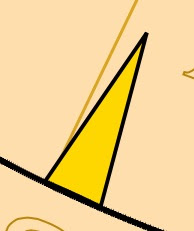As an equinox or a solstice (in this case) approaches, my year clock starts indicating the time of the event with increasing precision, using indicator arrows like the one shown below (each equinox and solstice has a unique arrow; this one is for the winter solstice).
While such arrows are visible year-round in the clock’s year ring, as the month of the event is entered an arrow appears at the exact point around the month ring’s outer circumference that corresponds to the time of the event. As the week of the event is entered, same thing … and so on for the day, hour, and minute rings. So, the approach (and retreat) of the event can be observed in real-time, if you happen to be of a mind to do so.
(If you only want to know the times of equinoxes and solstices, see my perpetual table of them.)
The year clock requires any version of Firefox, or the WebKit-based browsers like Safari and Chrome (WebKit currently has the better SVG engine, IMO), that have been released since about 2008. The latest Internet Explorer can probably handle the clock, too.




Cool! I'll give it a try from rural Poland. :)
ReplyDelete-johan
I just ran across some of your panoramas! You have a knack for doing everything that catches your interest exceptional well! Thank you for sharing it with us!
ReplyDelete